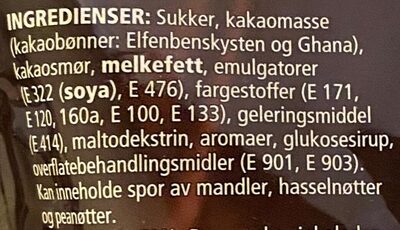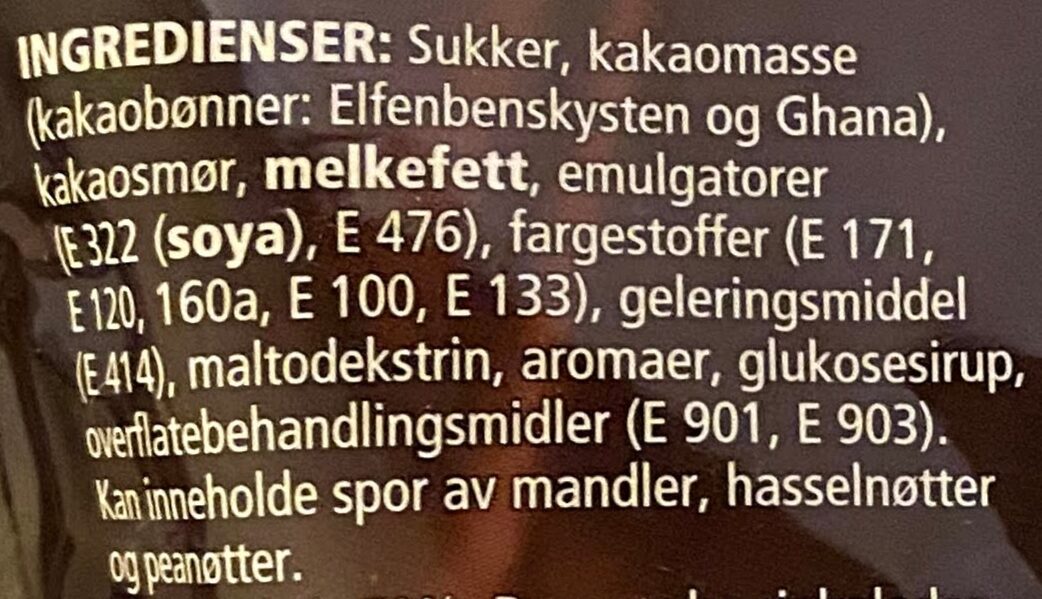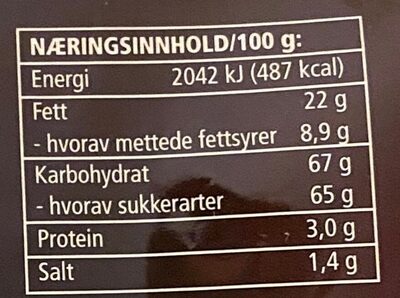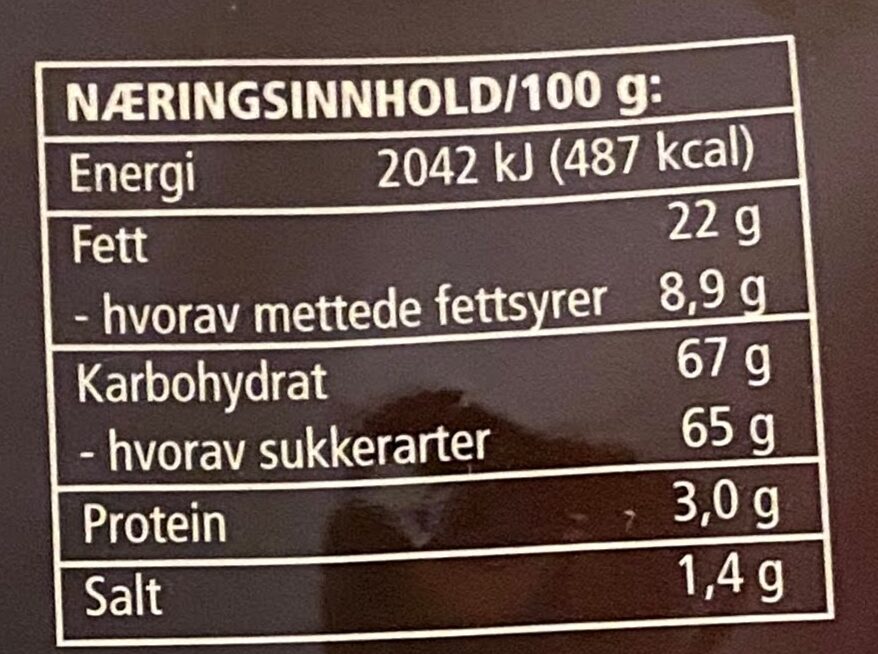Hjelp oss med å gjøre åpenhet om mat til det normale!
Som en ideell organisasjon, er vi avhengige av dine donasjoner for å fortsette å informere forbrukere verden over om hva de spiser.
Matrevolusjonen starter med deg!
Choco Lenses med sjokolade - Coop - 180 g
Choco Lenses med sjokolade - Coop - 180 g
Denne produktsiden er ikke fullstendig. Du kan hjelpe med å ferdigstille den ved å redigere den og legge til mere data fra bildene vi har, eller ved å ta flere bilder i appen for Android eller iPhone/iPad. Takk!
×
Strekkode: 7340191103382 (EAN / EAN-13)
Mengde: 180 g
Emballasje: en:Plastic
Merker: Coop, Zaklady Przemyslu Cukierniczego, Zaklady Przemyslu Cukierniczego Baltyk, ZPC Bałtyk
Kategorier: en:Snacks, en:Sweet snacks, en:Cocoa and its products, en:Confectioneries, en:Chocolate candies, en:Bonbons
Etiketter, sertifiseringer, priser:
en:Sustainable farming, UTZ Certified, UTZ Certified Cocoa
Produksjon- eller behandlingssteder: Poland
Lenke til produktsiden på den offisielle nettsiden til produsenten: https://matlevering.coop.no/snacks-og-go...
Butikker: Coop Extra
Land hvor produktet selges: Norge
Samsvarer med dine preferanser
Helse
Ingredienser
-
22 ingredienser
Sukker, kakaomasse (kakaobønner: Elfenbenskysten og Ghana), kakaosmør, melkefett, emulgatorer E322 (soya), E 476), fargestoffer (E 171, E 120, 160a, E 100, E 133), geleringsmiddel E414), maltodekstrin, aromaer, glukosesirup, overflatebehandlingsmidler (E 901, E 903). Kan inneholde spor av mandler, hasselnøtter og peanotter.Allergener: Melk, SoyaSpor: Nøtter
Matprosessering
-
Ultrabearbeidede matvarer
Elementer som indikerer at produkter er i en:4 - Ultra processed food and drink products-gruppen:
- Tilsetningsstoff: E100 - Kurkumin
- Tilsetningsstoff: E120 - Karmin
- Tilsetningsstoff: E133 - Briljantblà FCF
- Tilsetningsstoff: E160a - Karotener
- Tilsetningsstoff: E171 - Titandioxid
- Tilsetningsstoff: E322 - Lecitiner
- Tilsetningsstoff: E476
- Tilsetningsstoff: E901 - Bivoks
- Tilsetningsstoff: E903 - Karnaubavoks
- Ingrediens: Farge
- Ingrediens: Emulgeringsmiddel
- Ingrediens: Aroma
- Ingrediens: Overflatebehandlingsmiddel
- Ingrediens: Glukose
- Ingrediens: Glukosesirup
- Ingrediens: Maltodekstrin
Matvarer er inndelt i 4 grupper i henhold til bearbeidingsgraden:
- Ubearbeidet eller minimalt bearbeidet mat
- Bearbeidede kulinariske ingredienser
- Bearbeidet mat
- Ultrabearbeidede matvarer
Bestemmelsen av gruppa er basert på kategorien til produktet og på ingrediensene den inneholder.
Tilsetningsstoffer
-
E120 - Karmin
Carminic acid: Carminic acid -C22H20O13- is a red glucosidal hydroxyanthrapurin that occurs naturally in some scale insects, such as the cochineal, Armenian cochineal, and Polish cochineal. The insects produce the acid as a deterrent to predators. An aluminum salt of carminic acid is the coloring agent in carmine. Synonyms are C.I. 75470 and C.I. Natural Red 4. The chemical structure of carminic acid consists of a core anthraquinone structure linked to a glucose sugar unit. Carminic acid was first synthesized in the laboratory by organic chemists in 1991.Kilde: Wikipedia (Engelsk)
-
E133 - Briljantblà FCF
Brilliant Blue FCF: Brilliant Blue FCF -Blue 1- is an organic compound classified as a triarylmethane dye and a blue azo dye, reflecting its chemical structure. Known under various commercial names, it is a colorant for foods and other substances. It is denoted by E number E133 and has a color index of 42090. It has the appearance of a blue powder. It is soluble in water, and the solution has a maximum absorption at about 628 nanometers.Kilde: Wikipedia (Engelsk)
-
E160a - Karotener
Carotene: The term carotene -also carotin, from the Latin carota, "carrot"- is used for many related unsaturated hydrocarbon substances having the formula C40Hx, which are synthesized by plants but in general cannot be made by animals -with the exception of some aphids and spider mites which acquired the synthesizing genes from fungi-. Carotenes are photosynthetic pigments important for photosynthesis. Carotenes contain no oxygen atoms. They absorb ultraviolet, violet, and blue light and scatter orange or red light, and -in low concentrations- yellow light. Carotenes are responsible for the orange colour of the carrot, for which this class of chemicals is named, and for the colours of many other fruits, vegetables and fungi -for example, sweet potatoes, chanterelle and orange cantaloupe melon-. Carotenes are also responsible for the orange -but not all of the yellow- colours in dry foliage. They also -in lower concentrations- impart the yellow coloration to milk-fat and butter. Omnivorous animal species which are relatively poor converters of coloured dietary carotenoids to colourless retinoids have yellowed-coloured body fat, as a result of the carotenoid retention from the vegetable portion of their diet. The typical yellow-coloured fat of humans and chickens is a result of fat storage of carotenes from their diets. Carotenes contribute to photosynthesis by transmitting the light energy they absorb to chlorophyll. They also protect plant tissues by helping to absorb the energy from singlet oxygen, an excited form of the oxygen molecule O2 which is formed during photosynthesis. β-Carotene is composed of two retinyl groups, and is broken down in the mucosa of the human small intestine by β-carotene 15‚15'-monooxygenase to retinal, a form of vitamin A. β-Carotene can be stored in the liver and body fat and converted to retinal as needed, thus making it a form of vitamin A for humans and some other mammals. The carotenes α-carotene and γ-carotene, due to their single retinyl group -β-ionone ring-, also have some vitamin A activity -though less than β-carotene-, as does the xanthophyll carotenoid β-cryptoxanthin. All other carotenoids, including lycopene, have no beta-ring and thus no vitamin A activity -although they may have antioxidant activity and thus biological activity in other ways-. Animal species differ greatly in their ability to convert retinyl -beta-ionone- containing carotenoids to retinals. Carnivores in general are poor converters of dietary ionone-containing carotenoids. Pure carnivores such as ferrets lack β-carotene 15‚15'-monooxygenase and cannot convert any carotenoids to retinals at all -resulting in carotenes not being a form of vitamin A for this species-; while cats can convert a trace of β-carotene to retinol, although the amount is totally insufficient for meeting their daily retinol needs.Kilde: Wikipedia (Engelsk)
-
E171 - Titandioxid
Titanium dioxide: Titanium dioxide, also known as titaniumIV oxide or titania, is the naturally occurring oxide of titanium, chemical formula TiO2. When used as a pigment, it is called titanium white, Pigment White 6 -PW6-, or CI 77891. Generally, it is sourced from ilmenite, rutile and anatase. It has a wide range of applications, including paint, sunscreen and food coloring. When used as a food coloring, it has E number E171. World production in 2014 exceeded 9 million metric tons. It has been estimated that titanium dioxide is used in two-thirds of all pigments, and the oxide has been valued at $13.2 billion.Kilde: Wikipedia (Engelsk)
-
E322 - Lecitiner
Lecithin: Lecithin -UK: , US: , from the Greek lekithos, "egg yolk"- is a generic term to designate any group of yellow-brownish fatty substances occurring in animal and plant tissues, which are amphiphilic – they attract both water and fatty substances -and so are both hydrophilic and lipophilic-, and are used for smoothing food textures, dissolving powders -emulsifying-, homogenizing liquid mixtures, and repelling sticking materials.Lecithins are mixtures of glycerophospholipids including phosphatidylcholine, phosphatidylethanolamine, phosphatidylinositol, phosphatidylserine, and phosphatidic acid.Lecithin was first isolated in 1845 by the French chemist and pharmacist Theodore Gobley. In 1850, he named the phosphatidylcholine lécithine. Gobley originally isolated lecithin from egg yolk—λέκιθος lekithos is "egg yolk" in Ancient Greek—and established the complete chemical formula of phosphatidylcholine in 1874; in between, he had demonstrated the presence of lecithin in a variety of biological matters, including venous blood, in human lungs, bile, human brain tissue, fish eggs, fish roe, and chicken and sheep brain. Lecithin can easily be extracted chemically using solvents such as hexane, ethanol, acetone, petroleum ether, benzene, etc., or extraction can be done mechanically. It is usually available from sources such as soybeans, eggs, milk, marine sources, rapeseed, cottonseed, and sunflower. It has low solubility in water, but is an excellent emulsifier. In aqueous solution, its phospholipids can form either liposomes, bilayer sheets, micelles, or lamellar structures, depending on hydration and temperature. This results in a type of surfactant that usually is classified as amphipathic. Lecithin is sold as a food additive and dietary supplement. In cooking, it is sometimes used as an emulsifier and to prevent sticking, for example in nonstick cooking spray.Kilde: Wikipedia (Engelsk)
-
E476
Polyglycerol polyricinoleate: Polyglycerol polyricinoleate -PGPR-, E476, is an emulsifier made from glycerol and fatty acids -usually from castor bean, but also from soybean oil-. In chocolate, compound chocolate and similar coatings, PGPR is mainly used with another substance like lecithin to reduce viscosity. It is used at low levels -below 0.5%-, and works by decreasing the friction between the solid particles -e.g. cacao, sugar, milk- in molten chocolate, reducing the yield stress so that it flows more easily, approaching the behaviour of a Newtonian fluid. It can also be used as an emulsifier in spreads and in salad dressings, or to improve the texture of baked goods. It is made up of a short chain of glycerol molecules connected by ether bonds, with ricinoleic acid side chains connected by ester bonds. PGPR is a yellowish, viscous liquid, and is strongly lipophilic: it is soluble in fats and oils and insoluble in water and ethanol.Kilde: Wikipedia (Engelsk)
-
E901 - Bivoks
Beeswax: Beeswax -cera alba- is a natural wax produced by honey bees of the genus Apis. The wax is formed into "scales" by eight wax-producing glands in the abdominal segments of worker bees, which discard it in or at the hive. The hive workers collect and use it to form cells for honey storage and larval and pupal protection within the beehive. Chemically, beeswax consists mainly of esters of fatty acids and various long-chain alcohols. Beeswax has long-standing applications in human food and flavoring. For example, it is used as a glazing agent or as a light/heat source. It is edible, in the sense of having similar negligible toxicity to plant waxes, and is approved for food use in most countries and the European Union under the E number E901. However, the wax monoesters in beeswax are poorly hydrolysed in the guts of humans and other mammals, so they have insignificant nutritional value. Some birds, such as honeyguides, can digest beeswax. Beeswax is the main diet of wax moth larvae.Kilde: Wikipedia (Engelsk)
-
E903 - Karnaubavoks
Carnauba wax: Carnauba -; Portuguese: carnaúba [kaʁnɐˈubɐ]-, also called Brazil wax and palm wax, is a wax of the leaves of the palm Copernicia prunifera -Synonym: Copernicia cerifera-, a plant native to and grown only in the northeastern Brazilian states of Piauí, Ceará, Maranhão, Bahia, and Rio Grande do Norte. It is known as "queen of waxes" and in its pure state, usually comes in the form of hard yellow-brown flakes. It is obtained from the leaves of the carnauba palm by collecting and drying them, beating them to loosen the wax, then refining and bleaching the wax.Kilde: Wikipedia (Engelsk)
Analyse av ingredienser:
-
en:May contain palm oil
Ingredienser som kan inneholde palmeolje: Melkefett, E160a
-
en:Non-vegan
Ikke-veganske ingredienser: Melkefett, E120, E901Noen ingredienser kunne ikke gjenkjennes.
Vi trenger din hjelp!
Du kan hjelpe oss med å gjenkjenne flere ingredienser og bedre analysere ingredienslista for dette produktet og andre ved å:
- Rediger denne produktsiden for å korrigere skrivefeil i ingredienslista, og/eller for å fjerne ingredienser på andre språk og setninger som ikke er knyttet til ingrediensene.
- Legg inn nye oppføringer, synonymer eller oversettelser til våre flerspråklige ingredienslister, ingrediensbearbeidingsmetoder, og etiketter.
Bli med i kanalen #ingredients på vårt Slack-samtalested og/eller lære om ingrediensanalyse på wikien vår, hvis du ønsker å hjelpe til. Tusen takk!
-
en:Non-vegetarian
Ikke-vegetarianske ingredienser: E120Noen ingredienser kunne ikke gjenkjennes.
Vi trenger din hjelp!
Du kan hjelpe oss med å gjenkjenne flere ingredienser og bedre analysere ingredienslista for dette produktet og andre ved å:
- Rediger denne produktsiden for å korrigere skrivefeil i ingredienslista, og/eller for å fjerne ingredienser på andre språk og setninger som ikke er knyttet til ingrediensene.
- Legg inn nye oppføringer, synonymer eller oversettelser til våre flerspråklige ingredienslister, ingrediensbearbeidingsmetoder, og etiketter.
Bli med i kanalen #ingredients på vårt Slack-samtalested og/eller lære om ingrediensanalyse på wikien vår, hvis du ønsker å hjelpe til. Tusen takk!
-
Detaljer fra analysen av ingrediensene
Vi trenger din hjelp!
Noen ingredienser kunne ikke gjenkjennes.
Vi trenger din hjelp!
Du kan hjelpe oss med å gjenkjenne flere ingredienser og bedre analysere ingredienslista for dette produktet og andre ved å:
- Rediger denne produktsiden for å korrigere skrivefeil i ingredienslista, og/eller for å fjerne ingredienser på andre språk og setninger som ikke er knyttet til ingrediensene.
- Legg inn nye oppføringer, synonymer eller oversettelser til våre flerspråklige ingredienslister, ingrediensbearbeidingsmetoder, og etiketter.
Bli med i kanalen #ingredients på vårt Slack-samtalested og/eller lære om ingrediensanalyse på wikien vår, hvis du ønsker å hjelpe til. Tusen takk!
nb: Sukker, kakaomasse (kakaobønner), kakaosmør, melkefett, emulgatorer (e322), e476, fargestoffer (e171, e120, e160a, e100, e133), geleringsmiddel e414, maltodekstrin, aromaer, glukosesirup, overflatebehandlingsmidler (e901, e903), og peanotter- Sukker -> en:sugar - vegan: yes - vegetarian: yes - ciqual_proxy_food_code: 31016 - percent_min: 7.69230769230769 - percent_max: 100
- kakaomasse -> en:cocoa-paste - vegan: yes - vegetarian: yes - ciqual_proxy_food_code: 16030 - percent_min: 0 - percent_max: 50
- kakaobønner -> nb:kakaobønner - percent_min: 0 - percent_max: 50
- kakaosmør -> en:cocoa-butter - vegan: yes - vegetarian: yes - ciqual_food_code: 16030 - percent_min: 0 - percent_max: 33.3333333333333
- melkefett -> en:milkfat - vegan: no - vegetarian: yes - from_palm_oil: maybe - percent_min: 0 - percent_max: 25
- emulgatorer -> en:emulsifier - percent_min: 0 - percent_max: 20
- e322 -> en:e322 - vegan: maybe - vegetarian: maybe - percent_min: 0 - percent_max: 20
- e476 -> en:e476 - vegan: yes - vegetarian: yes - percent_min: 0 - percent_max: 16.6666666666667
- fargestoffer -> en:colour - percent_min: 0 - percent_max: 14.2857142857143
- e171 -> en:e171 - vegan: yes - vegetarian: yes - percent_min: 0 - percent_max: 14.2857142857143
- e120 -> en:e120 - vegan: no - vegetarian: no - percent_min: 0 - percent_max: 7.14285714285714
- e160a -> en:e160a - vegan: maybe - vegetarian: maybe - from_palm_oil: maybe - percent_min: 0 - percent_max: 4.76190476190476
- e100 -> en:e100 - vegan: yes - vegetarian: yes - percent_min: 0 - percent_max: 3.57142857142857
- e133 -> en:e133 - vegan: yes - vegetarian: yes - percent_min: 0 - percent_max: 2.85714285714286
- geleringsmiddel e414 -> nb:geleringsmiddel-e414 - percent_min: 0 - percent_max: 12.5
- maltodekstrin -> en:maltodextrin - vegan: yes - vegetarian: yes - percent_min: 0 - percent_max: 11.1111111111111
- aromaer -> en:flavouring - vegan: maybe - vegetarian: maybe - percent_min: 0 - percent_max: 5
- glukosesirup -> en:glucose-syrup - vegan: yes - vegetarian: yes - ciqual_proxy_food_code: 31016 - percent_min: 0 - percent_max: 5
- overflatebehandlingsmidler -> en:glazing-agent - percent_min: 0 - percent_max: 5
- e901 -> en:e901 - vegan: no - vegetarian: yes - percent_min: 0 - percent_max: 5
- e903 -> en:e903 - vegan: yes - vegetarian: yes - percent_min: 0 - percent_max: 2.5
- og peanotter -> nb:og-peanotter - percent_min: 0 - percent_max: 5
Ernæring
-
Dårlig ernæringskvalitet
⚠ ️Advarsel: mengden fiberer ikke spesifisert, deres mulige positive bidrag til karakteren kunne ikke tas med i betraktningen.⚠ ️Advarsel: mengden frukt, grønnsaker og nøtter er ikke spesifisert på etiketten, den ble anslått utfra ingredienslista: 0Dette produktet regnes ikke som en drikke under beregningen av Nutri-Score.
Positive poeng: 0
- Protein: 1 / 5 (verdi: 3, avrundet verdi: 3)
- Fiber: 0 / 5 (verdi: 0, avrundet verdi: 0)
- Frukt, grønnsaker, nøtter, og raps/valnøtt/olivenoljer: 0 / 5 (verdi: 0, avrundet verdi: 0)
Negative poeng: 30
- Energi: 6 / 10 (verdi: 2042, avrundet verdi: 2042)
- Sukker: 10 / 10 (verdi: 65, avrundet verdi: 65)
- Mettet fett: 8 / 10 (verdi: 8.9, avrundet verdi: 8.9)
- Natrium: 6 / 10 (verdi: 560, avrundet verdi: 560)
Poengene for proteiner telles ikke fordi de negative poengene er større eller lik 11.
Ernæringsverdi: (30 - 0)
Nutri-Score:
-
Næringsnivåer
-
Fett i høy kvantitet (22%)
Fint å vite- Et høyt inntak av fett, spesielt mettet fett, kan øke kolesterolet, som øker risikoen for hjertesjukdommer.
Anbefaling: Reduser inntaket av fett og mettet fett- Velg produkter med lavere fett- og mettet fettinnhold.
-
Mettet fett i høy kvantitet (8.9%)
Fint å vite- Et høyt inntak av fett, spesielt mettet fett, kan øke kolesterolet, som øker risikoen for hjertesjukdommer.
Anbefaling: Reduser inntaket av fett og mettet fett- Velg produkter med lavere fett- og mettet fettinnhold.
-
Sukkerarter i høy kvantitet (65%)
Fint å vite- Et høyt inntak av sukker kan føre til økning i vekt og tannråte. Det øker også risikoen for diabetes type 2 og hjerte- og karsjukdommer.
Anbefaling: Begrens inntaket av sukker og sukkerholdige drikker- Sukkerholdige drikker (som brus, fruktdrikker, og fruktjuicer og nektar) burde begrenses så mye som mulig (ikke mer enn 1 glass om dagen).
- Velg produkter med lavt sukkerinnhold og reduser inntaket av produkter med tilsatt sukker.
-
Salt i moderat mengde (1.4%)
Fint å vite- Et høyt inntak av salt (eller sodium) kan føre til et økt blodtrykk, som kan føre til høyere risiko for hjertesjukdom og slag.
- Mange folk har høyt blodtrykk uten å vite det, siden det ofte ikke er noen symptomer.
- De fleste inntar for mye salt (i gjennomsnitt 9 til 12 gram per dag), cirka det dobbelte av den anbefalte høyeste mengden av inntak.
Anbefaling: Begrens inntaket av salt og saltet mat- Reduser mengden salt som brukes ved matlaging, og ikke salt igjen ved bordet.
- Begrens inntaket av salte snacks og velg produkter med lavere saltinnhold.
-
-
Ernæringsinnhold
Ernæringsinnhold Som solgt
for 100 g / 100 mlSom solgt
per porsjon (45 g)Sammenlignet med: en:Bonbons Energi 2 042 kj
(487 kcal)919 kj
(219 kcal)−3 % Fett 22 g 9,9 g −18 % Mettet fett 8,9 g 4,01 g −46 % Karbohydrat 67 g 30,2 g +19 % Sukkerarter 65 g 29,2 g +32 % Kostfiber ? ? Protein 3 g 1,35 g −46 % Salt 1,4 g 0,63 g +506 % Fruits‚ vegetables‚ nuts and rapeseed‚ walnut and olive oils (estimate from ingredients list analysis) 0 % 0 %
Miljø
-
Eco-Score ikke beregnet - Ukjent miljøavtrykk
Vi kunne ikke beregne Eco-Scoren til dette produktet siden det mangler noen data, kunne du hjulpet med å fullføre det?Kan du legge til en presis produktkategori sånn at vi kan beregne Eco-Scoren? Legg til en kategori
Emballasje
-
Emballasje med moderat avtrykk
-
Emballasjedeler
1 x Bag (07 OTHER: 5.5 g)
-
Emballasjematerialer
Material % Emballasjevekt Emballasjevekt per 100 g produkt Plastic 100% 5.5 g 3.1 g
-
Transport
-
Opprinnelsen til ingredienser
Opprinnelsene til ingredienser med et høyt avtrykk
Opprinnelsen til produktet og/eller dets ingredienser % av ingredienser Påvirkning Unknown 77 %Høy Elfenbenskysten 12 %Moderat Ghana 12 %Høy
Etiketter
Report a problem
-
Incomplete or incorrect information?
Category, labels, ingredients, allergens, nutritional information, photos etc.
If the information does not match the information on the packaging, please complete or correct it. Open Food Facts is a collaborative database, and every contribution is useful for all.
Datakilder
Produkt lagt til av aucampia-gmail-com
Siste redigering av produktsiden den av odinh.
Produktside også redigert av itsjustruby, moon-rabbit, openfoodfacts-contributors, packbot.













